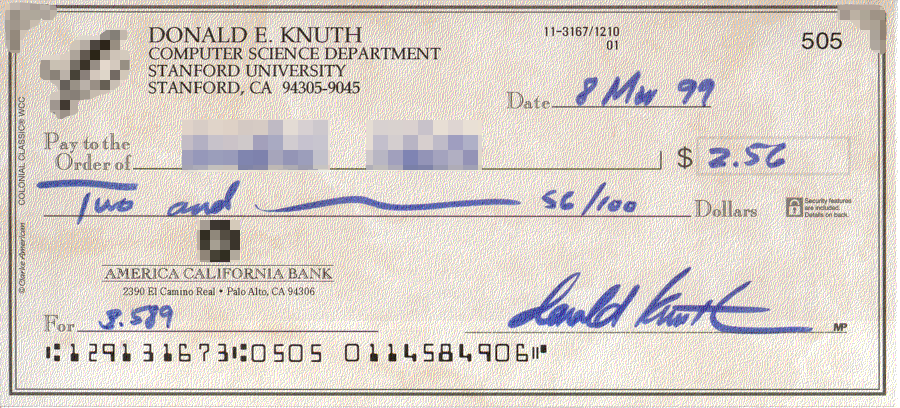|
Concrete Roman
Concrete Roman is a slab serif typeface designed by Donald Knuth using his METAFONT program. It was intended to accompany the Euler mathematical font which it partners in Knuth's book ''Concrete Mathematics''. It has a darker appearance than its more famous sibling, Computer Modern Computer Modern is the original family of typefaces used by the typesetting program TeX. It was created by Donald Knuth with his Metafont program, and was most recently updated in 1992. Computer Modern, or variants of it, remains very widely u .... Some favour it for use on the computer screen because of this, as the thinner strokes of Computer Modern can make it hard to read at low resolutions. External linksComputer Modern family for general use select .otf fonts Typefaces designed by Donald Knuth Slab serif typefaces TeX {{Typ-stub ... [...More Info...] [...Related Items...] OR: [Wikipedia] [Google] [Baidu] |
Serif
In typography, a serif () is a small line or stroke regularly attached to the end of a larger stroke in a letter or symbol within a particular font or family of fonts. A typeface or "font family" making use of serifs is called a serif typeface (or serifed typeface), and a typeface that does not include them is sans-serif. Some typography sources refer to sans-serif typefaces as "grotesque" (in German language, German, ) or "Gothic", and serif typefaces as "Roman type, roman". Origins and etymology Serifs originated from the first official Greek writings on stone and in Latin alphabet with Roman square capitals, inscriptional lettering—words carved into stone in Roman Classical antiquity, antiquity. The explanation proposed by Father Edward Catich in his 1968 book ''The Origin of the Serif'' is now broadly but not universally accepted: the Roman letter outlines were first painted onto stone, and the stone carvers followed the brush marks, which flared at stroke ends and corners, ... [...More Info...] [...Related Items...] OR: [Wikipedia] [Google] [Baidu] |
Slab Serif
In typography, a slab serif (also called ''mechanistic'', ''square serif'', ''antique'' or ''Egyptian'') typeface is a type of serif typeface characterized by thick, block-like serifs. Serif terminals may be either blunt and angular ( Rockwell), or rounded (Courier). Slab serifs were introduced in the early nineteenth century. Slab serifs form a large and varied genre. Some such as Memphis and Rockwell have a geometric design with minimal variation in stroke width: they are sometimes described as sans-serif fonts with added serifs. Others such as those of the Clarendon genre have a structure more like most other serif fonts, though with larger and more obvious serifs. These designs may have bracketed serifs which increase width along their length before merging with the main strokes of the letters, while on geometrics the serifs have a constant width. Display-oriented slab serifs are often extremely bold, intended to grab the reader's attention on a poster, while slab serifs ... [...More Info...] [...Related Items...] OR: [Wikipedia] [Google] [Baidu] |
Donald Knuth
Donald Ervin Knuth ( ; born January 10, 1938) is an American computer scientist, mathematician, and professor emeritus at Stanford University. He is the 1974 recipient of the ACM Turing Award, informally considered the Nobel Prize of computer science. Knuth has been called the "father of the analysis of algorithms". He is the author of the multi-volume work '' The Art of Computer Programming'' and contributed to the development of the rigorous analysis of the computational complexity of algorithms and systematized formal mathematical techniques for it. In the process, he also popularized the asymptotic notation. In addition to fundamental contributions in several branches of theoretical computer science, Knuth is the creator of the TeX computer typesetting system, the related METAFONT font definition language and rendering system, and the Computer Modern family of typefaces. As a writer and scholar, Knuth created the WEB and CWEB computer programming systems designed to ... [...More Info...] [...Related Items...] OR: [Wikipedia] [Google] [Baidu] |
AMS Euler
AMS Euler is an upright cursive typeface, commissioned by the American Mathematical Society (AMS) and designed and created by Hermann Zapf with the assistance of Donald Knuth and his Stanford graduate students. It tries to emulate a mathematician's style of handwriting mathematical entities on a blackboard, which is upright rather than italic. It blends very well with other typefaces made by Hermann Zapf, such as Palatino, Aldus and Melior, but very badly with the default TeX font Computer Modern. All the alphabets were implemented with the computer-assisted design system Metafont developed by Knuth. Zapf designed and drew the Euler alphabets in 1980–81 and provided critique and advice of digital proofs in 1983 and later. The typeface family is copyright by American Mathematical Society, 1983. Euler Metafont development was done by Stanford computer science and/or digital typography students; first Scott Kim, then Carol Twombly and Daniel Mills, and finally David Siegel, al ... [...More Info...] [...Related Items...] OR: [Wikipedia] [Google] [Baidu] |
Concrete Mathematics
''Concrete Mathematics: A Foundation for Computer Science'', by Ronald Graham, Donald Knuth, and Oren Patashnik, first published in 1989, is a textbook that is widely used in computer-science departments as a substantive but light-hearted treatment of the analysis of algorithms. Contents and history The book provides mathematical knowledge and skills for computer science, especially for the analysis of algorithms. According to the preface, the topics in ''Concrete Mathematics'' are "a blend of CONtinuous and disCRETE mathematics". Calculus is frequently used in the explanations and exercises. The term "concrete mathematics" also denotes a complement to "abstract mathematics". The book is based on a course begun in 1970 by Knuth at Stanford University. The book expands on the material (approximately 100 pages) in the "Mathematical Preliminaries" section of Knuth's ''The Art of Computer Programming''. Consequently, some readers use it as an introduction to that series of books ... [...More Info...] [...Related Items...] OR: [Wikipedia] [Google] [Baidu] |
Computer Modern
Computer Modern is the original family of typefaces used by the typesetting program TeX. It was created by Donald Knuth with his Metafont program, and was most recently updated in 1992. Computer Modern, or variants of it, remains very widely used in scientific publishing, especially in disciplines that make frequent use of mathematical notation. Design Computer Modern is a 'Didone', or modern serif font, a genre that emerged in the late 18th century as a contrast to the more organic designs that preceded them. Didone fonts have high contrast between thick and thin elements, and their axis of "stress" or thickening is perfectly vertical. Computer Modern was specifically based on the 10 point size of the American Lanston Monotype Company's Modern Extended 8A, part of a family Monotype originally released in 1896. This was one of many modern faces issued by typefounders and Monotype around this period, and the standard style for body text printing in the late nineteenth centur ... [...More Info...] [...Related Items...] OR: [Wikipedia] [Google] [Baidu] |
Typefaces Designed By Donald Knuth
A typeface (or font family) is the design of lettering that can include variations in size, weight (e.g. bold), slope (e.g. italic), width (e.g. condensed), and so on. Each of these variations of the typeface is a font. There are thousands of different typefaces in existence, with new ones being developed constantly. The art and craft of designing typefaces is called ''type design''. Designers of typefaces are called '' type designers'' and are often employed by ''type foundries''. In desktop publishing, type designers are sometimes also called ''font developers'' or ''font designers''. Every typeface is a collection of glyphs, each of which represents an individual letter, number, punctuation mark, or other symbol. The same glyph may be used for characters from different scripts, e.g. Roman uppercase A looks the same as Cyrillic uppercase А and Greek uppercase alpha. There are typefaces tailored for special applications, such as cartography, astrology or mathematics. Te ... [...More Info...] [...Related Items...] OR: [Wikipedia] [Google] [Baidu] |
Slab Serif Typefaces
Slab or SLAB may refer to: Physical materials * Concrete slab, a flat concrete plate used in construction * Stone slab, a flat stone used in construction * Slab (casting), a length of metal * Slab (geology), that portion of a tectonic plate that is subducting ** Slab pull force, the tectonic plate force due to subduction ** Slab suction, one of the major plate tectonic driving forces ** Slab window, a gap that forms in a subducted oceanic plate ** Slab (fossil) and counter slab, the two counterparts of a fossil impression * Slab hut, a kind of dwelling made from slabs of split or sawn timber * Slab of beer, a flat package containing a large number of cans of beer Places * Slab Point, a rocky point in the South Shetland Islands, Antarctica United States * Slab, West Virginia, an unincorporated community in Ritchie County, West Virginia * Slab City, California, a locality in the Colorado Desert * Slab City, Wisconsin, an unincorporated community in Shawano County, Wisconsin * ... [...More Info...] [...Related Items...] OR: [Wikipedia] [Google] [Baidu] |



